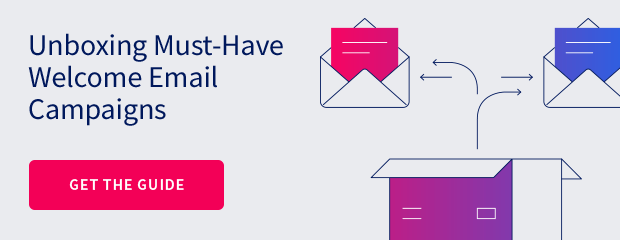Have you ever been blown off right from the start? Ever been “ghosted” just after meeting someone—be it a potential business contact, friend or dating partner—you really liked and thought you were hitting it off with?
Whether you’ve experienced it first-hand or just heard the horror stories, ghosting totally sucks.
If you can relate, then you get why welcome campaigns aren’t just vital but critical to email success. Not only do they set the tone for the entire future of your subscriber relationships, but they also ensure those subscriber connections become relationships. They pave the way for good deliverability (inbox vs. junk folder placement), and they create familiarity, appreciation, engagement and (most importantly) trust.
Failing to send a welcome message after email sign-up or address capture is the digital equivalent of ghosting your subscribers. And we know what happens to ghosters—they get blocked, ignored, forgotten or downright hated on.
Ok, so you’re sending a welcome email, but is it a kick-ass welcome campaign or a vanilla, one-size-fits-all message that sounds like it could’ve been cranked out by an AI-driven robot with zero human intervention? (Or maybe it’s so bad, the AI-driven robot version would be an improvement?)
It’s not enough to merely send a welcome email—although that’s better than not sending one at all—you need a strategic, personal message with zazz. Your welcome campaign should have specific goals, you should know what they are, and it should be crafted intentionally to accomplish them.
Plus, cutting-edge marketers know the welcome email is just the tip of the relationship-building iceberg, since they’re connecting it with an entire onboarding series to follow.
Still not convinced? Research shows a warm email welcome is more than just polite common sense, it’s a money-maker.
MarketingSherpa reports the average open rate for welcome emails is a whopping 50% (that’s the average), making them 86% more effective than your usual broadcast messages.
As if that’s not enough, according to Internet Retailer, merchants that send a welcome series see 13% more revenue than those sending a single message. Any way you cut it, welcome emails put engagement and money in the bank.
But, going beyond basic isn’t for wimps. Let’s make sure you’re doing it right with a breakdown of 4 essential ingredients for marketing success.
Want even more advanced tactics for welcome campaigns that soar? Download our latest guide, Unboxing Must-Have Marketing Campaigns: Welcome Emails.
Essential Ingredients
1. Welcome, Introduce & Establish Identity
You got it—the whole point of a welcome email is to actually make a new subscriber feel welcome, so write your subject lines, headlines and copy that way! Show gratitude and appreciation like you would if you were meeting in person.
Think about how you’d welcome someone into your home or a special event: you’d invite them in, make sure they’re in the right place, and introduce yourself so they know exactly who you are and how to recognize you again.
Food gift merchant Fairytale Brownies’ welcome campaign scores! I’m feeling the warm, gooey brownie love right from the subject line with my “gift inside.”
The fact that I’m greeted as a “Fairytale Friend” and am receiving “much love” from co-founders (and real-life kindergarten friends—yeah, for real) David and Eileen, plus get to actually see what they look like, only adds to the yummy goodness. (Now, if I only had a glass of red wine to go with those brownies, but I digress…)
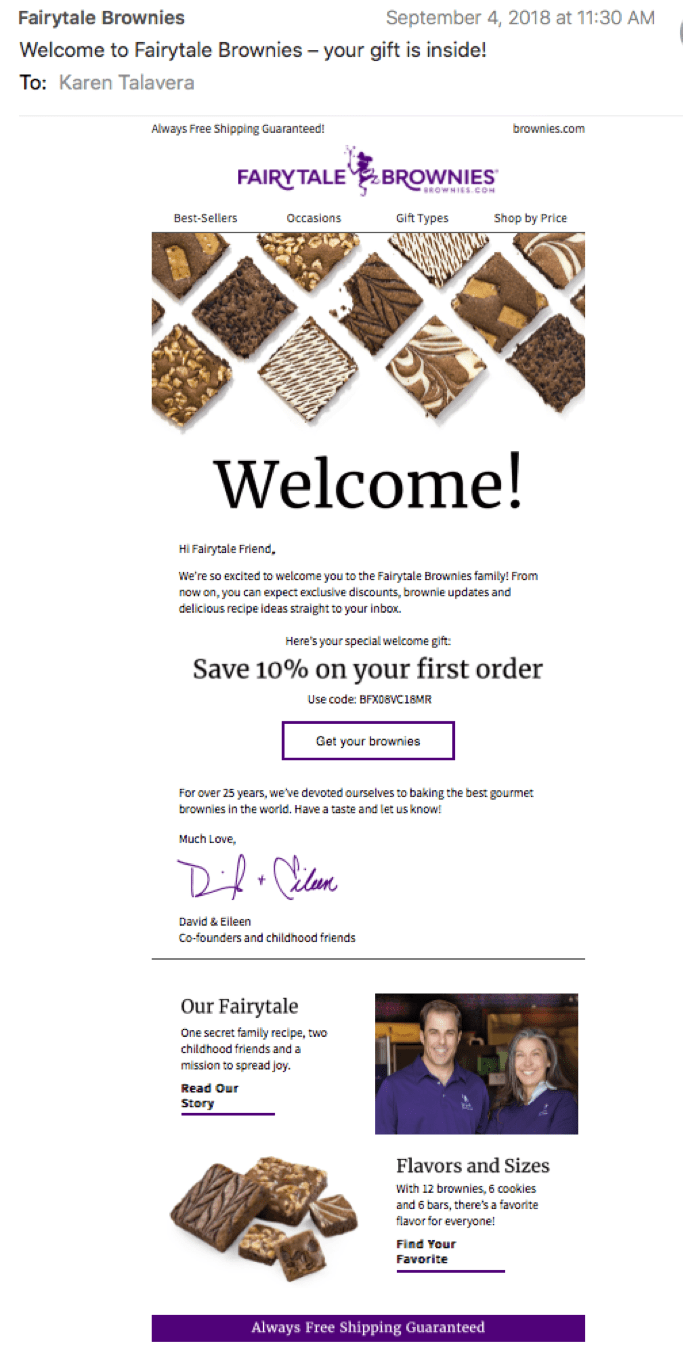

Fairytale Brownies Welcome With Email Offer
Getting serious for a sec, let’s not overlook the importance of establishing inbox identity.
With ISPs cracking down on spam and monitoring inbox owner engagement like never before, today’s email welcome campaigns need to clearly establish brand and sender identity to ensure successful deliverability.
Your visible “From” name, as well as your email sending address and domain should be recognizable entities to subscribers, even if it means having to explain things a bit (such as a parent company domain that’s different from a retail store brand name).
You don’t want new subscribers blocking or blacklisting you right from the get-go because they can’t connect the dots between what they signed up for and how you show up in the inbox.
2. Confirm Actions, Manage Expectations
What did you promise when you asked for an email address? Was it required as part of a mobile app download or purchase? Contest or sweepstakes entry? For access to gated content? Or were you just popping up a lightbox doling out the usual (but nonetheless appreciated) 10% discount or free shipping on first purchase?
There’s a myriad of ways to end up on an email list and many—like entering a contest, registering for an event, downloading content, or creating an account—have nothing to do with intentionally signing up for email to get deals or perks.
Whatever you promised, make sure you’re telling subscribers that’s how and why they came to be on your list, that they’ve successfully completed the action, and what’s in store for them next.
Here’s what I received after joining British Airways’ frequent flyer program “Executive Club” (which sounds soooo much more elite than it is—oh those British!) after having purchased an international flight on Iberia, their partner airline. The animated hero shot is a catchy touch and not often seen in welcome emails—nice!
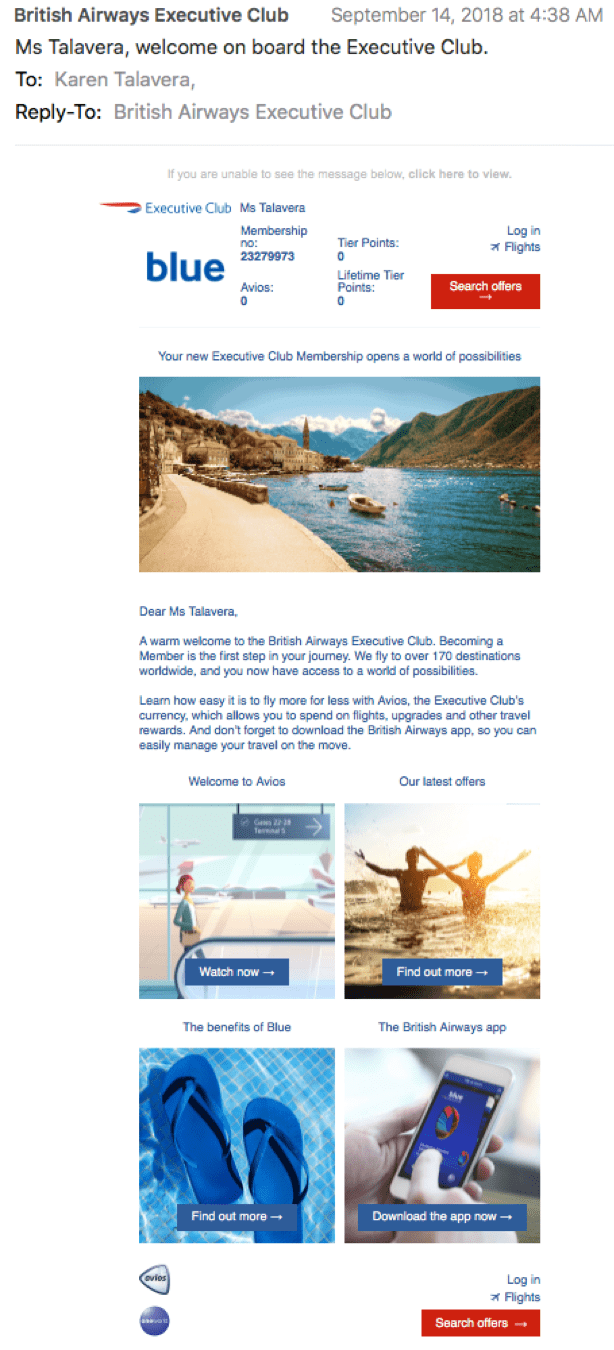

British Airways Executive Club Welcome Message
More to the point, the message clearly does its job by letting me know my membership number (if any of you international road warriors would like to apply it to your next BA flight, feel free), points status, and other useful information like program benefits and how to get their mobile app.
3. Orient and Guide
In the spirit of travel, your welcome email is a key inflection point at the start of a very important journey—the customer journey. Whether people ended up on your email list because they bought or they have yet to, your goal is the same: get them to transact.
As on any journey, people want to know the landscape. They’d like to know where they’re going and how to get there, so give them a map, as well as step-by-step directions. Don’t just leave them wandering in the wilderness.
This welcome email from eBags not only includes a hefty bounceback offer (a 25% discount on repeat purchase—that’s pretty motivating even though I dropped $400 on my first purchase), but also attractively enumerates what I need to know and do next, one step at a time.
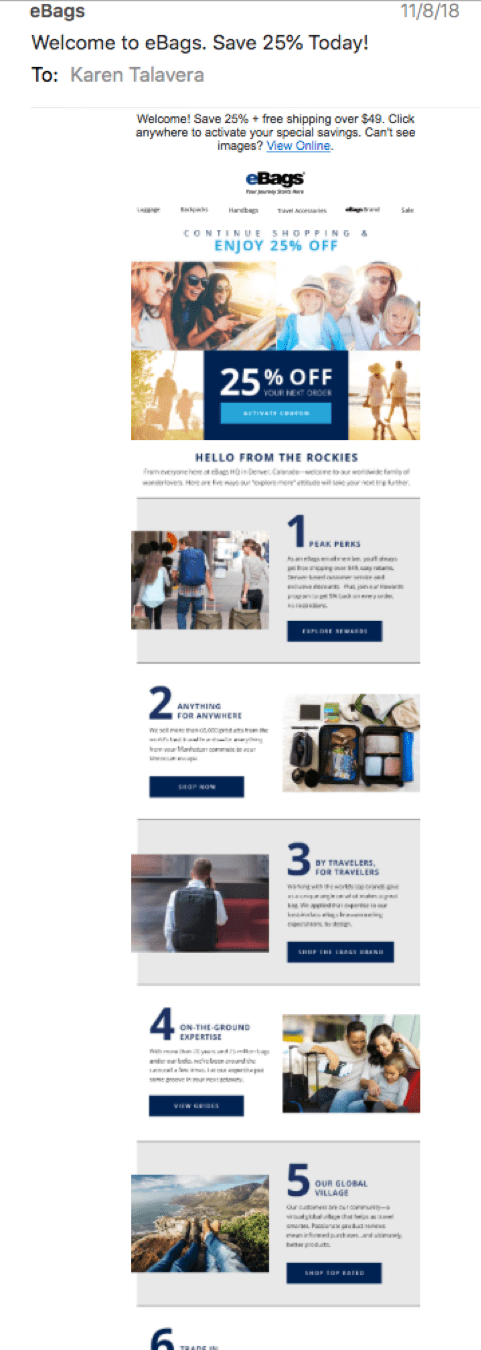

eBags Getting Started Message
A stellar touch I’m calling out is the inclusion of content marketing in point #4—which links to juicy-good information like travel guides, packing lists, and interviews with their “eBags Ambassadors,” real people embodying different customer personas.
This was no small investment to create, and as a frequent traveler myself, I both appreciate the effort and resonate strongly with it. I’m already feeling real connection to this brand!
Remember—forging relationships is a core objective of your welcome campaigns, so evoking positive emotions will go a long way toward creating attachment and loyalty.
4. Prioritize Key Next Steps
eBags’ numbered CTAs in the previous example aptly illustrate this point, but what if walking new subscribers down the garden path isn’t as important as getting them to take a specific required action—like setting up a profile or account—before anything can happen that generates value for either of you?
Or, what if you have a BHAG (big hairy audacious goal) like growing social media followers or gathering feedback that depends on subscribers taking a specific action, like following your Instagram or completing a poll?
Here’s a real-life example involving a two-part email confirm/welcome to illustrate my point. I recently made a purchase in a Columbia Sportswear retail store. The cashier asked me if I wanted to join the rewards program, and I said yes. She asked for my email address, I verbally gave it, and then received this message.
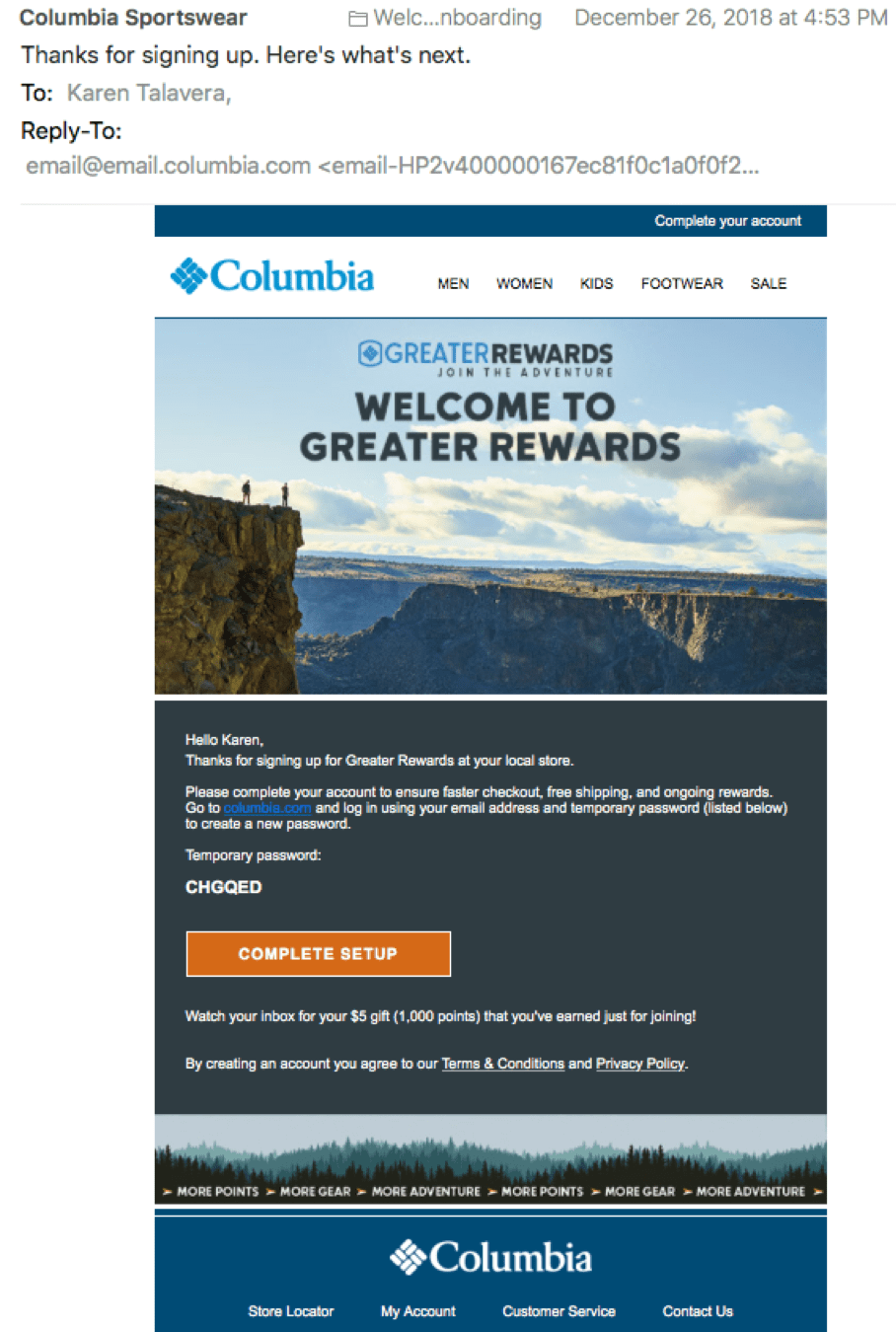

Columbia Sportswear Signup in Store – Account Completion
Clearly, Columbia was forcing account creation for rewards program members—I wouldn’t be able to join and earn without completing setup. But the process was short and simple and the temporary password provided, so I did it. With account setup done, a second more typical welcome email followed.
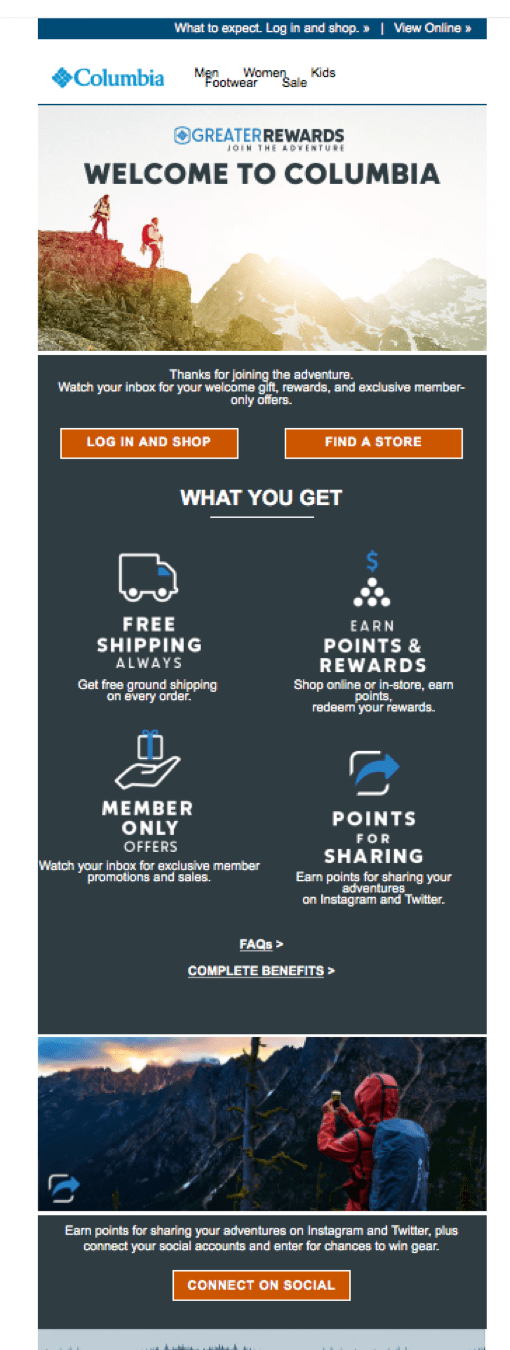

Columbia Sportswear Welcome Email Follow-up
The moral of the story? If you need a new subscriber to do something before a relationship can be established at all, hand-hold them through the process and plan for additional emails to support it.
Ready to go beyond the basics? Download our latest guide, Unboxing Must-Have Marketing Campaigns: Welcome Emails, for more advanced tactics.
If that’s not enough to chew on, here’s a heap of welcome email inspiration from our friends at Really Good Emails.
Now that you’ve considered what’s possible, how will you evolve your welcome email campaigns this year?































